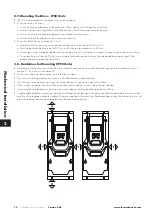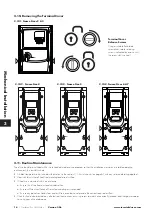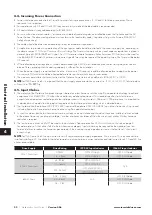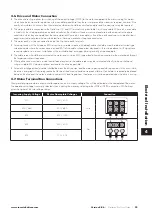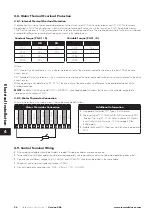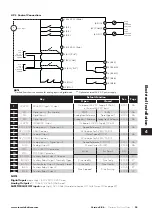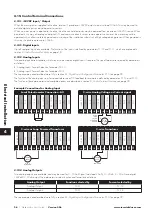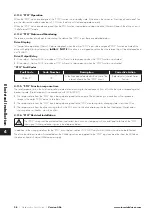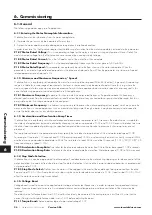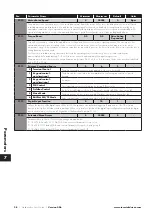
Version 3.06
| Optidrive Eco User Guide |
27
www.invertekdrives.com
4.10.5. Auxiliary Relay Outputs
Two relay outputs are available, which are intended to be used to switch external resistive loads up to 5A at 230 VAC or 30VDC.
Relay 1 has both normally open and normally closed contacts available. Relay 2 provides a simple open or closed contact.
The relay output function may be configured using parameters P2-15 and P2-18, which are described in section
8.1. Digital Input
Configuration Parameter P1-13
on page 39.
4.11. Safe Torque Off
Safe Torque OFF will be referred to as “STO” through the remainder of this section.
4.11.1. Responsibilities
The overall system designer is responsible for defining the requirements of the overall “Safety Control System” within which the drive
will be incorporated; furthermore the system designer is responsible for ensuring that the complete system is risk assessed and that the
“Safety Control System” requirements have been entirely met and that the function is fully verified, this must include confirmation testing
of the “STO” function before drive commissioning.
The system designer shall determine the possible risks and hazards within the system by carrying out a thorough risk and hazard
analysis, the outcome of the analysis should provide an estimate of the possible hazards, furthermore determine the risk levels and
identify any needs for risk reduction. The “STO” function should be evaluated to ensure it can sufficiently meet the risk level required.
4.11.2. What STO Provides
The purpose of the “STO“ function is to provide a method of preventing the drive from creating torque in the motor in the absence of
the “STO“ input signals (Terminal 12 with respect to Terminal 13), this allows the drive to be incorporated into a complete safety control
system where “STO“ requirements need to be fulfilled.
1
The “STO“ function can typically eliminate the need for electro-mechanical contactors with cross-checking auxiliary contacts as per
normally required to provide safety functions.
2
The drive has the “STO“ Function built-in as standard and complies with the definition of “Safe torque off“ as defined by
IEC 61800-5-2:2007.
The “STO“ Function also corresponds to an uncontrolled stop in accordance with category 0 (Emergency Off), of IEC 60204-1. This
means that the motor will coast to a stop when the “STO” function is activated, this method of stopping should be confirmed as being
acceptable to the system the motor is driving.
The “STO“ function is recognised as a failsafe method even in the case where the “STO“ signal is absent and a single fault within the
drive has occurred, the drive has been proven in respect of this by meeting the following safety standards:
SIL
(Safety Integrity
Level)
PFHD
(Probability of dangerous
Failures per Hour)
SFF
(Safe failure
fraction %)
Lifetime
assumed
EN 61800-5-2
2
1.23E-09 1/h (0.12 % of SIL 2)
50
20 Yrs
PL
(Performance Level)
CCF (%)
(Common Cause Failure)
MTTFd
Category
EN ISO 13849-1
PL d
1
4525a
3
SILCL
EN 62061
SILCL 2
NOTE
The values achieved above maybe jeopardised if the drive is installed outside of the Environmental limits detailed in section
11.1. Environmental.
Disconnect and ISOLATE the drive before attempting any work on it. The “STO“ function does not prevent high voltages
from being present at the drive power terminals.
1
NOTE
The “STO“ function does not prevent the drive from an unexpected re-start. As soon as the “STO“ inputs receive
the relevant signal it is possible (subject to parameter settings) to restart automatically, Based on this, the function should not
be used for carrying out short-term non-electrical machinery operations (such as cleaning or maintenance work).
2
NOTE
In some applications additional measures may be required to fulfil the systems safety function needs: the “STO“
function does not provide motor braking. In the case where motor braking is required a time delay safety relay and/or a
mechanical brake arrangement or similar method should be adopted, consideration should be made over the required
safety function when braking as the drive braking circuit alone cannot be relied upon as a fail safe method.
When using permanent magnet motors and in the unlikely event of a multiple output power devices failing then the motor
could effectively rotate the motor shaft by 180/p degrees (Where p denotes number of motor pole pairs).
4
Elec
trical Installation


